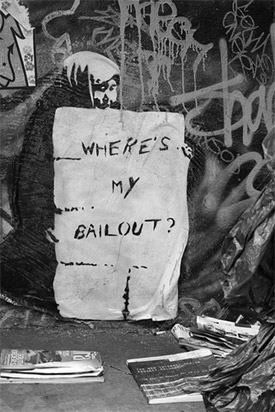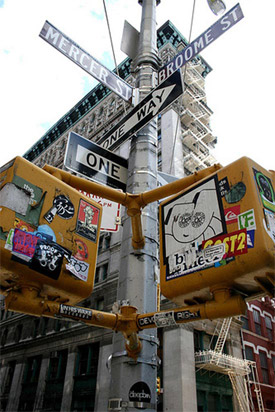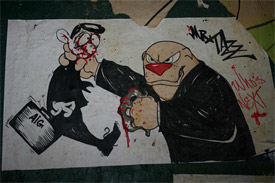The sardonic graffiti appearing around New York’s SoHo lately seems incongruous, since this is one of the city’s wealthiest neighborhoods.
“Where’s my bailout?” a homeless woman asks in one stencil.
Another, in a pink makeshift frame with the words “The greatest depression” scribbled on it, shows a man being silenced by a United States of Debt dollar bill.
Graffiti has always adorned the buildings of SoHo, the formerly industrial Manhattan neighborhood that attracted artists with its spacious lofts in the ’70s, and today is home to top boutiques, restaurants, and galleries.
But the new wave of recession-themed graffiti feels like a throwback, or at least a vibrant collage of frustration and parody.
“It’s a free outlet for people to express themselves to a large audience,” said Timothy Kephart, creator of Graffiti Tracker, a web program that interprets graffiti. “Ironically, to express their displeasure with the economy, you could argue that the vandalism has a negative economic impact both in the monetary loss and in the quality of life loss.”
But some welcome the fresh dose of color.
“It’s awesome,” said Julian Kouyoumjian, a salesman at Kid Robot, a counterculture store on Spring Street that draws much of its essence from the graffiti scene. “We actually collaborate with a lot of street artists,” Kouyoumjian said. “It’s really popular and goes hand in hand with the stuff you see in here.”
And with new works appearing daily outside their doors, even some galleries can’t resist grafitti’s guerrilla appeal.
“It gives the neighborhood character,” said Alexandra Tayne, director of Lumas Editions Gallery on Wooster Street.
A poster depicting a man with “F___ the stock market, buy art” tagged along his sunglass lenses got Tayne thinking about the economy’s impact on the art industry.
Many SoHo gallery art buyers tend to work in the financial sector, she said, so times are also tough for galleries that rely on one big sale per month. “Luckily for us, we deal entirely with photography,” she explained. “So if we need to adjust prices, we can just make more prints. There will still be a limited number, and just a few are signed. Art has never been stopped by a recession.”
The community board that serves as the neighborhood’s main local voice doesn’t share the enthusiasm for street art.
“SoHo, like much of CB2, is landmarked,” said district manager Bob Gormley. “If graffiti is defined as any sort of tagging, writing, or painting on property owned by someone else, and doing so without the owner’s permission, it is always illegal. If a graffiti artist has the owner’s permission, that is a different matter. However, any such work would have to be in compliance with the city’s landmark laws.”
Certain pieces — like an illustration of an AIG employee being pummeled in the face by a pair of brass knuckles — seemed unlikely to win approval, anyway.
Resident complaints have waned considerably, though. Everyblock.com, a website that uses the mayor’s Community Affairs Unit database to compile data graffiti cleanup requests, indicated that complaints dropped significantly after the recession.
From January 2008 to April 2009, 101 graffiti cleanup requests were filed in SoHo, 70 by August 2008. But from September 2008 (when the investment bank Lehman Brothers collapsed, an event linked to the beginning of the recession) to March 2009, a mere 31 requests were filed.
Maybe SoHo residents are discovering an appreciation for graffiti. Or maybe they have bigger things to worry about nowadays.
“My apartment has been hit with graffiti, and it feels terrible,” said New York University student Louis Formica. “I didn’t ask for it to be tagged. It’s a strange feeling to know someone stood outside your house and vandalized it.”
If only bad news graffiti could always be on someone else’s property.
SoHo graffiti turns topical.



- Follow us on Twitter: @inthefray
- Comment on stories or like us on Facebook
- Subscribe to our free email newsletter
- Send us your writing, photography, or artwork
- Republish our Creative Commons-licensed content

